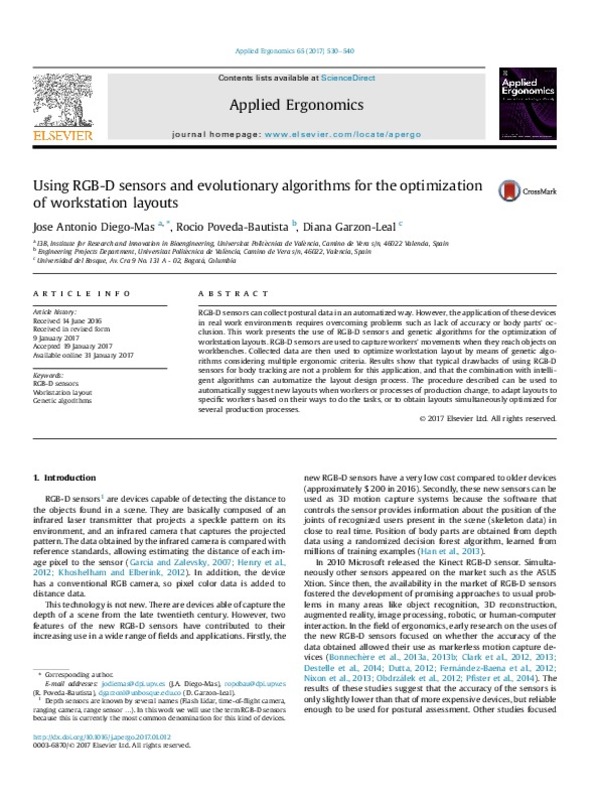JavaScript is disabled for your browser. Some features of this site may not work without it.
Buscar en RiuNet
Listar
Mi cuenta
Estadísticas
Ayuda RiuNet
Admin. UPV
Using RGB-D sensors and evolutionary algorithms for the optimization of workstation layouts
Mostrar el registro sencillo del ítem
Ficheros en el ítem
| dc.contributor.author | Diego-Mas, Jose Antonio
|
es_ES |
| dc.contributor.author | Poveda Bautista, Rocio
|
es_ES |
| dc.contributor.author | Garzon-Leal, Diana
|
es_ES |
| dc.date.accessioned | 2018-06-02T04:22:24Z | |
| dc.date.available | 2018-06-02T04:22:24Z | |
| dc.date.issued | 2017 | es_ES |
| dc.identifier.issn | 0003-6870 | es_ES |
| dc.identifier.uri | http://hdl.handle.net/10251/103237 | |
| dc.description.abstract | [EN] RGB-D sensors can collect postural data in an automatized way. However, the application of these devices in real work environments requires overcoming problems such as lack of accuracy or body parts' occlusion. This work presents the use of RGB-D sensors and genetic algorithms for the optimization of workstation layouts. RGB-D sensors are used to capture workers' movements when they reach objects on workbenches. Collected data are then used to optimize workstation layout by means of genetic algorithms considering multiple ergonomic criteria. Results show that typical drawbacks of using RGB-D sensors for body tracking are not a problem for this application, and that the combination with intelligent algorithms can automatize the layout design process. The procedure described can be used to automatically suggest new layouts when workers or processes of production change, to adapt layouts to specific workers based on their ways to do the tasks, or to obtain layouts simultaneously optimized for several production processes. | es_ES |
| dc.description.sponsorship | This work was supported by the Programa estatal de investigacion, desarrollo e innovacion orientada a los retos de la sociedad of the Government of Spain under Grant TIN2013-42504-R. | en_EN |
| dc.language | Inglés | es_ES |
| dc.publisher | Elsevier | es_ES |
| dc.relation.ispartof | Applied Ergonomics | es_ES |
| dc.rights | Reserva de todos los derechos | es_ES |
| dc.subject | RGB-D sensors | es_ES |
| dc.subject | Workstation layout, Genetic algorithms | es_ES |
| dc.subject.classification | PROYECTOS DE INGENIERIA | es_ES |
| dc.title | Using RGB-D sensors and evolutionary algorithms for the optimization of workstation layouts | es_ES |
| dc.type | Artículo | es_ES |
| dc.identifier.doi | 10.1016/j.apergo.2017.01.012 | es_ES |
| dc.relation.projectID | info:eu-repo/grantAgreement/MINECO//TIN2013-42504-R/ES/USO DE SENSORES DE PROFUNDIDAD DE BAJO COSTE PARA LA EVALUACION ERGONOMICA DE PUESTOS DE TRABAJO/ | es_ES |
| dc.rights.accessRights | Abierto | es_ES |
| dc.contributor.affiliation | Universitat Politècnica de València. Departamento de Proyectos de Ingeniería - Departament de Projectes d'Enginyeria | es_ES |
| dc.description.bibliographicCitation | Diego-Mas, JA.; Poveda Bautista, R.; Garzon-Leal, D. (2017). Using RGB-D sensors and evolutionary algorithms for the optimization of workstation layouts. Applied Ergonomics. 65:530-540. doi:10.1016/j.apergo.2017.01.012 | es_ES |
| dc.description.accrualMethod | S | es_ES |
| dc.relation.publisherversion | http://dx.doi.org/10.1016/j.apergo.2017.01.012 | es_ES |
| dc.description.upvformatpinicio | 530 | es_ES |
| dc.description.upvformatpfin | 540 | es_ES |
| dc.type.version | info:eu-repo/semantics/publishedVersion | es_ES |
| dc.description.volume | 65 | es_ES |
| dc.relation.pasarela | S\340508 | es_ES |
| dc.contributor.funder | Ministerio de Economía, Industria y Competitividad | es_ES |






![[Cerrado]](/themes/UPV/images/candado.png)


